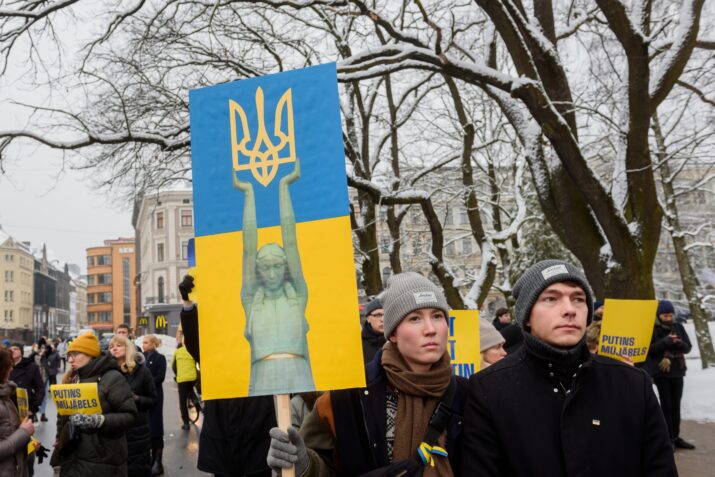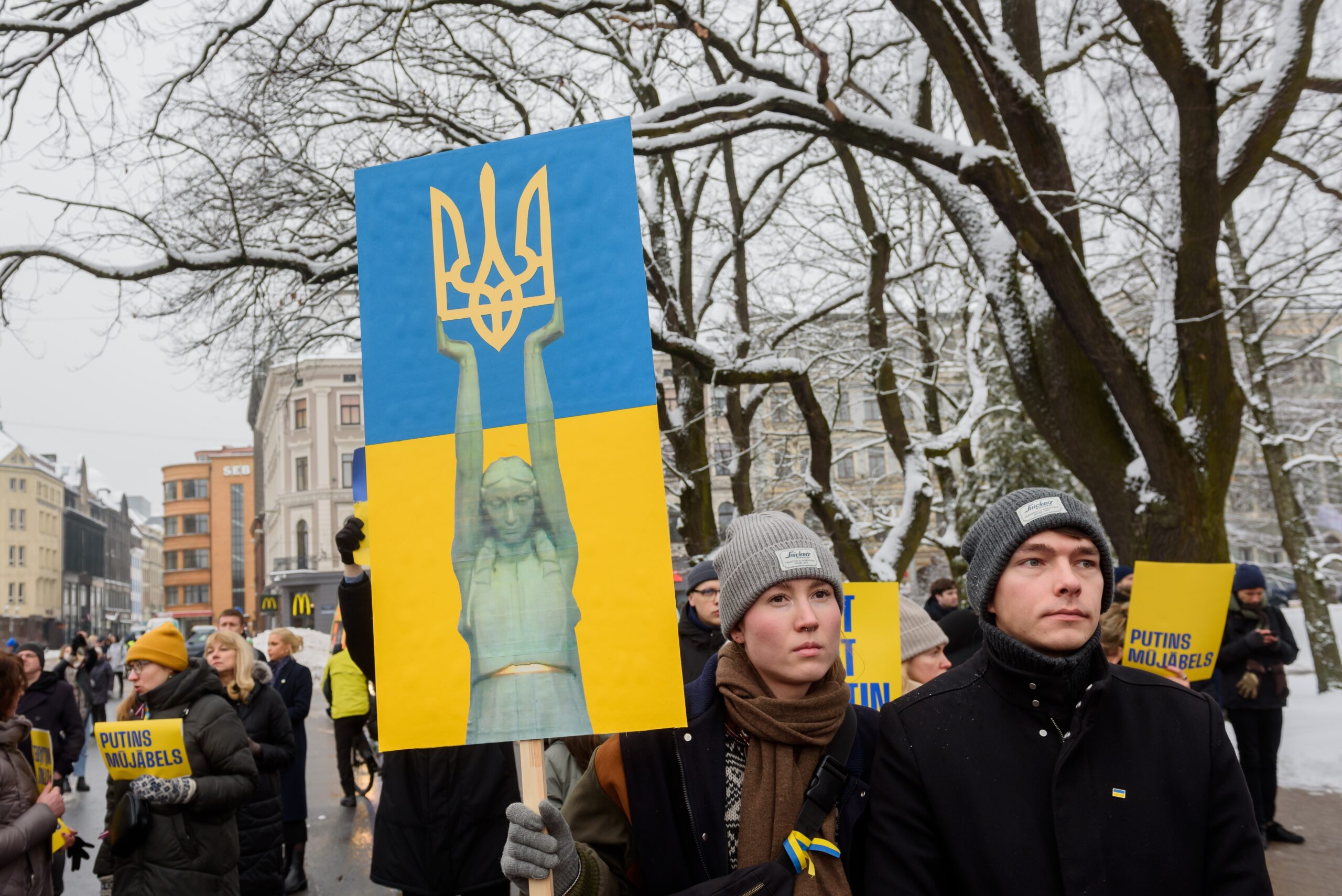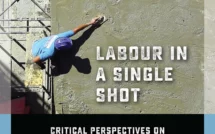

This is part of a series on the Ukraine Crisis.
Lost amidst the immense coverage of the battles in Ukraine and the political and economic uncertainty in Russia is the fact that Vladimir Putin’s war in Ukraine has melted the frozen conflicts in the nearby Baltic States in a way that has upended modern history. This is a geopolitical outcome of the war that should not be overlooked. Putin has long attempted to create so-called frozen conflicts in the Baltic States by utilizing three tactics. First, he has sought to destabilize Northeastern Europe via the propagandistic mobilization of the Russian-speaking minority, as well as via accusations that those Russian speakers have experienced extreme persecution. Second, the Kremlin has aided and abetted pro-Russia parties and separatists. Third, Putin’s regime has threatened NATO and the EU with a nuclear attack, fossil-fuel terrorism, or cyberwarfare if they attempt to gain too much influence in Russia’s so-called near abroad. This version of the frozen conflicts in the Baltic States, which centers on geopolitics and Russian minorities, can be termed the international frozen conflict. There has been a second, less well-known frozen conflict which might be called the domestic frozen conflict. For all of modern history, the Estonians, Latvians, and Lithuanians, fearing that they are not strong enough to stand alone in the dangerous geopolitical borderlands, have debated whether to ally with the powers of the East or West. This internal conflict has been the proverbial Gordian knot of Baltic politics.
Recent events, particularly the removal of Soviet-era monuments and policies regarding May 9 commemorations, suggest that the war in Ukraine has steeled the resolve of Baltic governments to combat Putin’s tactics and fully break with the Soviet past. Consequently, whereas previously Putin rather successfully used Russian speakers in the Baltic States as a kind of political Trojan horse, today the pro-Russia parties have become all but obsolete. As for the domestic frozen conflict, there is an unprecedented level of unanimity. Whereas before the war there was still a high level of anti-EU sentiment amongst some parts of Baltic societies, and whereas some efforts were made to economically deal with Russia and participate in China’s Belt and Road Initiative, now there is consensus that unequivocal membership in the West is the only way forward.
The domestic frozen conflict
In modern history, the Baltic nations have had only two brief periods of independence. The first one commenced in 1918, when the great empires of the region collapsed at the end of the First World War. That independence lasted until 1940, when the Soviet Red Army invaded. The second era of independence began in 1990-91, with the collapse of the Soviet Union. As a longue durée backdrop to the stage of Baltic politics is the history of foreign subjugation. First was the arrival of German crusaders and traders at the beginning of the thirteenth century. Thus began the “700-year curse of German oppression,” a phrase that Balts use in reference to the bitter history of serfdom and the socio-economic dominance of Baltic Germans. Second, from the eighteenth century up to 1918, the Baltic peoples lived in the Russian Empire, where they experienced fluctuating levels of Russification. Here is the upshot, then: within their national histories, Baltic peoples have had mostly negative interactions with outside political powers, whether to the east or west. Thus, when the Baltic nations first declared their independence in 1918, it was not a foregone conclusion that they would align themselves with the West, especially since the Bolsheviks were promising autonomy for all national minorities. Of course, most people in these nations came to side with membership in the West, but they were disappointed and dismayed by how long it took the Western powers to recognize their independence (e.g., the United States did not do so until 1922). For Balts, this sowed seeds of doubt about whether Western powers would be good allies.
The brutal occupations of the Second World War only heightened distrust of the outside powers. The Baltic nations experienced three separate occupations: the Soviets occupied them in 1940-41, the Germans did so from 1941-1944, and the Soviets occupied them for a second time from 1944 to 1990/91. Of course, the Baltic nations later learned that the first Soviet occupation was the result of the Nazi-Soviet Pact, whose secret protocol ceded control of the Baltic States to the Soviet Union. It was a brutal lesson about the cynicism of outside powers. It is also vital to note that the international frozen conflict developed as a byproduct of Josef Stalin’s occupation policies, which saw some 500,000 people from the Baltic States deported to gulag camps, followed by the resettlement of Russians in the Baltic republics (roughly 880,000 Russians in the case of Latvia alone). Suddenly, the Baltic States went from having small Russian-speaking communities to a very sizeable Russian minority. While some Russian speakers ultimately left during the late Soviet period, even today Estonia and Latvia have large Russian minorities. We will return to this issue later.
Upon regaining independence, the Baltic nations were not naïve about their political prospects. Turning to the east was not an option due to the bitter memories of Soviet rule, and Russia’s economy was also in shambles. But trusting the West was fraught with challenges, as evidenced by their hesitation to recognize and support Baltic independence. Although the implementation of neoliberal-capitalist reforms in the 1990s resulted in many tribulations, the post-Soviet decision to turn to the West seemed to be paying off as the new millennium began. By 2004, the Baltic States had gained admission to NATO and the European Union. But those monumental developments were not celebrated by all, for some citizens worried that membership in the EU would cede sovereignty to the bureaucrats in Brussels or the bankers in Berlin.
Those anxieties were eased by the economic boom that took place after EU admission. The case of Latvia is most telling. Between 2004-2007, GDP growth hovered around 10 percent, and wage growth reached 20-30 percent per annum. But in hindsight it was clear that this was a dangerous situation. Membership in the EU had meant easy access to foreign credit. Individually and collectively, Latvians took out loans, often from German and Swedish banks, to finance all sorts of things, and the country, which had been starved of major investment for decades, became dangerously overleveraged. Then the Great Recession hit in 2008, and Latvia’s credit-fueled boom suddenly halted. By 2009, Latvia’s GPD had dropped by roughly 25 percent, the worst mark in the EU. Ultimately, the Latvian government had to ask for EU and IMF bailout loans. But in order to receive the funds, the government had to adopt strict austerity measures. Fiscal cuts worth 18 percent of GDP were implemented and 30 percent of workers in the public sector were laid off. Those who kept their jobs saw their salary cut by up to 40 percent. Clearly, austerity was harsh medicine. However, by 2012, the EU and IMF were trumpeting the fact that the medicine had worked. That year the economy grew by 5 percent, the best mark in the EU. Prime Minister Valdis Dombrovskis was hailed by EU and IMF leaders as a faithful steward of austerity—and as a needed role model for politicians elsewhere in Eastern Europe who were flouting austerity. But that upbeat story did not hold. Instead, Latvia was hit by two catastrophes.
On November 21, 2013, the roof of the brand-new Maxima grocery store in Riga suddenly collapsed. Tragically, 54 people were killed. The roof did not collapse from the weight of an early winter snow. Rather, the roof fell in because of faulty construction, and Latvians were quick to note that the government agency tasked with inspecting buildings and monitoring new construction had been ravaged by austerity cuts. In a shocking development, Prime Minister Dombrovskis resigned, noting that he accepted the political consequences of the disaster. Dombrovskis’s seemingly stellar career, which had been backed by the EU, had collapsed as rapidly as the roof of that store. The second tragedy was a demographic one. In response to austerity cuts at home and better job prospects elsewhere in the EU, droves of Latvians left Latvia. By 2015, Latvia had suffered a demographic decline of 15 percent. Sadly, that trend has continued. As of 2022, Latvia’s population was 30 percent smaller than it was in 1990.
Unsurprisingly, Latvians began to wonder if membership in the West was proving to be a good thing. Thus, some residents began to pursue political alternatives. Russian speakers overwhelmingly voted for parties that campaigned on closer relations with Russia. Of those parties, Harmony (Saskaņa) was the main one and became a major player in Latvian politics, though Latvian parties always managed to keep them out of parliamentary coalitions. Regarding Latvian speakers, they have been leery of closer ties with Russia. But the aftermath of austerity did see the Latvian government look east—to China. In November 2016, the Latvian government signed a memorandum of understanding to take part in China’s Belt and Road Initiative. In conjunction with that diplomatic event, Riga Stradiņš University opened a China Studies Center, and the Latvian Institute of International Affairs inaugurated a New Silk Road program. Estonia and Lithuania followed closely behind in terms of inking partnerships with the Chinese. By 2021, it was unclear whether the Baltic nations might ultimately end up turning to the far east, and in the age of Brexit, this was a legitimate concern. But then everything changed in 2022. Putin ordered the invasion of Ukraine. The Chinese refused to condemn Putin’s actions. And Xi Jinping amped up geopolitical tensions by threatening Taiwan.
The response of the Baltic nations has been breathtakingly bold. First, they publicly quit their partnerships with China by blasting Xi Jinping for not siding with Ukraine and making clear that they will stand with Taiwan. The Lithuanians have gone so far as to permit the Taiwanese to open a diplomatic office in Vilnius. Second, the war has prompted the Baltic nations to reaffirm their ties to the West. This has been in part possible because Baltic leaders finally started being respected and fully listened to by Western leaders. Lithuania’s Foreign Minister Gabrielius Landsbergis got it right when he said in a recent interview that the period of “Westplaining” to the peoples of the Baltic States is now over. Whereas in the past Western diplomats would explain to the Balts why their paranoia about Putin and Russia was mostly unfounded and a mere product of their “special history,” now the Baltic leaders have the ears of the Western world. The third major response has been a resurgence of national pride. Again, the case of Latvia is telling. In 2010, in the midst of austerity, a public survey found that only 35 percent of Latvians had a positive view of the second period of independence—an astonishingly low number. The war has reminded everyone that independence cannot be taken for granted. Thus, the Latvian government has announced that compulsory military service for men will be implemented starting in 2023. Politically, it has meant that Latvian voters have rallied behind nationalist and pro-West parties. The current prime minister, Krišjānis Kariņš, has greatly benefited from this political shift. In contrast, the pro-Russia parties have suffered a catastrophic decline. For example, during the elections held in October 2022, Harmony failed to gain even a single seat in the parliament. Such a development would have been unimaginable prior to the war. To summarize, whereas the Baltic nations have vacillated between East and West for all of modern history, today there is a unanimous commitment to the West that is historically unprecedented.
The international frozen conflict
Due to the legacy of Stalin’s occupation policies, the Russian minority makes up between 25-30 percent of the overall population in Estonia and Latvia. In Lithuania, the number is roughly 5 percent. Since 1991, the Baltic States have struggled to deal with Russian speakers who were born prior to renewed independence. Though there are slight differences in the three countries’ policies, generally speaking these Russian speakers had to make decisions regarding citizenship, for they were not automatically granted it. They could move to the Russian Federation or stay. If the latter, then they had to decide whether to pursue citizenship in the Baltic country or obtain Russian citizenship so as to apply for a residency permit. Still a further possibility for them was to refuse all citizenship and end up with the now infamous “alien” grey passport. For some Russians, there were hard feelings about not obtaining automatic citizenship since they had lived their entire lives there, and those feelings were compounded by the fact that they had to pass a rudimentary language proficiency exam in order to get Baltic citizenship. Claiming that they are being discriminated against, many Russian speakers have resolutely refused to obtain citizenship. Over the years, various solutions have been proposed. For example, in Latvia pro-Russia parties such as Harmony have suggested that Russian be made a second official language, thus easing the path to citizenship and good employment. The Latvian nationalist parties rejected this proposal. When Russian speakers cry foul, the government responds by claiming that it is their duty to protect and uphold Latvian culture. Over the years, but especially since 2007, Putin’s regime has used propaganda to exacerbate these tensions over language and citizenship laws. The propaganda reached an apex in early 2022, when Putin falsely claimed that the Russians in Ukraine and the Baltic States were facing discrimination so intense that it should be labeled genocide.
Beyond language and citizenship issues, Putin has also used historical memory and debates about monuments to unsettle Baltic societies. For Balts, the monuments built during Soviet times have been visual, daily reminders of Soviet totalitarianism. Unsurprisingly, there has been discussion since 1991 about these monuments, such as the so-called Victory Monument in Riga. The first period of discussion took place early in the 1990s between the leaders of the Baltic republics and the Russian Federation. In return for Russia’s recognition of their independence, the Baltic countries promised not to destroy Soviet-era monuments or graves. However, as tensions between Russian speakers and Latvians and Estonians worsened, the monuments became the sites of protests, counterprotests, and occasional drunken brawls. For Russians, the sites were synonymous with Russian identity and pride in the glory days of the Soviet Union. For Balts, they were reminders that the Soviet past was not totally over. Thus, by 2007 discussions about monuments entered a new phase, and the question was this: Could these monuments at least be moved from less prominent locations to, say, cemeteries or museums?
Estonia was the first country to attempt this approach. In April 2007, the Estonian government moved the so-called Bronze Soldier monument from downtown Tallinn to the Tallinn military cemetery. Putin’s regime immediately broadcast anti-Estonian propaganda that resulted in Russian minorities waging two nights of violent protests in Estonia. One person was killed in the clashes, and property damage was extensive. What is more, the Kremlin ordered what is often considered the world’s first ever case of cyberwarfare. Estonia’s IT infrastructure was crippled. Putin’s message to the Baltic States was clear: he would not permit the upending of Soviet history, and Russian speakers would not be assimilated into Baltic societies. His goal was to create a frozen conflict over language, history, and identity, and up until 2022 his tactic worked. After what happened in Estonia, no Baltic country dared to move or destroy monuments, and relations between Russian speakers and Balts remained strained. But then Putin ordered the invasion of Ukraine, and everything changed.
Inspired by the example of Ukrainian resistance, the Baltic governments moved with shocking speed to solve the international frozen conflict. Sensing that their Russian speakers were breaking with Putin, the Baltic governments made an urgent push for citizenship and assimilation. It has worked. Just consider the case of Estonia, where the number of Russian speakers applying for citizenship has tripled in pace since the onset of the war. In the case of Latvia, the government announced in October 2022 that by the 2026-27 school year the Russian language will no longer be spoken in any Latvian school. Just a few years ago, Harmony was calling for Russian to be made the second official language of Latvia. Now, by 2026, the Russian language will be banned from all Latvian schools, and this announcement was met with little public protest.
Even more dramatic is the case of the removal of Soviet-era monuments. Baltic governments claimed that since Putin violated Ukrainian sovereignty, they no longer had to abide by the 1991 agreement to protect Soviet monuments. In all three Baltic countries, major monuments have been moved or destroyed in recent months. In Latvia, on August 26, 2022, the obelisk of the “Victory Monument” was toppled. The adjacent statues were also destroyed. Around the same time, the Estonians removed multiple monuments, including one in the very Russian town of Narva, which sits right at the Estonian-Russian border. In Lithuania, the authorities dismantled in December 2022 the Soviet monument at the Antakalnis Cemetery. In all three countries, the removal of the monuments did not lead to any significant protests or violence. The contrast between what happened after the Bronze Soldier was moved in 2007 and the removals of 2022 is stark and very telling.
In Latvia, the government has sensed the momentum and pressed forward with additional actions aimed at eliminating the troubling tradition of May 9. From 1945 on, the Soviet Union celebrated the end of WWII on May 9. This so-called Victory Day celebration has continued in Putin’s Russia. In contrast, Europe and the US have marked the occasion on May 8. Since the 1990s, May 8 and May 9 have been stressful days in the Baltic States. Like a flashpoint of the larger fight over identity and history, those who have continued to observe May 9 have been seen as hardcore Russian nationalists, Soviet apologists, and Putin supporters. Thus, every year tensions have risen and tempers flared when Russian speakers gathered at the Soviet-era monuments to mark May 9. But this year was different. Of course, the monuments are now gone, and because the monuments have been removed, the Latvian government also declared in April 2023 that it is now a crime to celebrate May 9 in any way. On May 8, 2023, the Latvian police forewarned Russian speakers with the following public announcement:
We remind you that placing flowers and other elements in places where the now demolished Soviet monuments were located can be seen as possible justification and glorification of totalitarian regimes, war crimes, and military aggression. Such acts will be considered as possible criminal offenses.
The Latvian government has been so serious about uprooting the May 9 tradition that it has even asked citizens to report violators via a special police phone hotline. Such assertive action would have been unimaginable before the war. Also telling is the fact that, despite the aggressiveness of Baltic governments to solve the international frozen conflict, the pro-Russia parties have not been able to politically capitalize on these potentially risky decisions. Instead, the pro-Russia parties have all but ceased to exist.
So, what does all of this mean? First, it seems that Putin committed a geopolitical blunder when he sent troops into Ukraine. For years, Putin was able to manipulate Russian speakers in the Baltic States, and in doing so he sowed much discord. But recent societal and political developments have indicated that Putin has now lost all of his influence in those countries. And there is little chance that he can win that back. The Baltic leaders know this is the case, and thus there is a level of optimism about civic nationalism that has never previously existed in the post-Soviet period. For example, in his speech on November 18, 2022 marking the anniversary of Latvia’s independence, President Egils Levits celebrated the fact that Latvia is becoming more Latvian. At first glance, this seems like an odd thing to say since Latvia has in fact gained more non-Latvian residents due to the war in Ukraine. For example, there are now more than 40,000 Ukrainian refugees living in Latvia, not to mention Russian political asylum seekers. What President Levits was actually speaking to, then, is the end of the frozen conflicts. For the first time, nearly all residents of Latvia are committed to the Latvian state and to Latvian independence.
Similarly, for the first time, Balts agree about their future: it is with the West. This, too, is a tremendous development. In the age of austerity, of Brexit, and of President Donald Trump’s disparagement of NATO and eschewal of global leadership, it was unclear whether the post-WWII liberal order would hold; and both Russia and China were determined to pick off countries on Europe’s eastern borderland. But the war in Ukraine has backfired on Putin because it turns out that 2022 saw the resurgence of NATO and European unity. And the Baltic leaders are taking the lead in ensuring that this unity does not crack amid the continued uncertainty of the war.
Jordan T. Kuck is Associate Professor of History at Brevard College in Brevard, North Carolina. A scholar of authoritarianism and fascism during the interwar period, he is currently working on a manuscript on Kārlis Ulmanis’s authoritarian regime in Latvia. Recent publications include chapters in edited volumes that marked the centennial of Latvian independence, as well as contributions in the edited volumes Dictatorship and Daily Life in Twentieth Century Europe (2022) and Transnational and Transatlantic Fascism in East Central and Southeastern Europe, 1918–2018 (forthcoming).
Image: Shutterstock | RIGA, LATVIA. 24th February 2023. Support rally for Ukraine.
Published on June 27, 2023.




